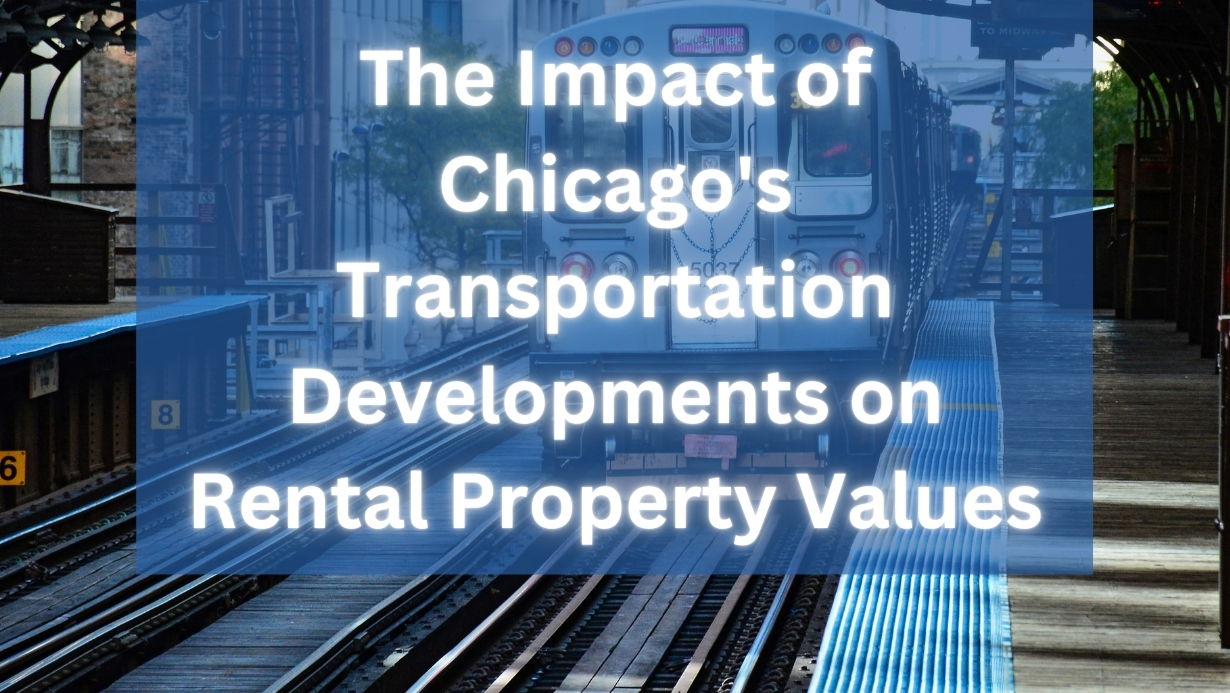In Chicago’s rental market, walking distance to a CTA station or express bus line often separates average units from high-demand rental properties. Proximity to transit doesn’t just save time—it enhances the resident experience. Tenants are willing to pay for that convenience!
As Chicago continues to expand and modernize its transportation system, these changes directly influence rent prices, rental demand, and the decisions that owners, real estate investors, and property managers make. Analyzing the local real estate market in each area, and considering factors like local economic health and rental demand, is crucial. If you own residential properties or are looking to invest in the city, this is more than a trend—it’s a strategic advantage.

The Future of Transit in Chicago (And Why It Matters for Rentals)
Major infrastructure projects like the Red and Purple Line Modernization (RPM), proposed O’Hare Express service, and expansion of protected bike lanes across Logan Square, Bronzeville, and Pilsen are actively reshaping how residents navigate the city.
These upgrades are doing more than reducing congestion. They’re boosting tenant satisfaction, increasing the value of nearby rental units, and creating investment opportunities for landlords who analyze trends early.
For example:
Uptown and Edgewater saw spikes in rental market activity following RPM upgrades at Lawrence and Bryn Mawr
Milwaukee Avenue’s bike-friendly redesign increased inquiries and visibility for studio and one-bedroom apartments
Property managers and landlords alike are seeing how access to reliable transit is becoming a priority for tenants. For example, new Divvy stations or bike lanes often coincide with rising inquiries for apartments nearby, while proposed train extensions can drive demand even before construction begins. Bike-friendly upgrades, including an expanded Divvy network and an additional 47 miles of bike lanes, will attract a new generation of clients moving toward car-free lifestyles.

What Factors Affect Rental Property Values?
Several factors can affect the value of rental properties in Chicago.
These include:
Location and proximity
Size
Condition of the property
Broader market trends
Economic conditions.
Properties located in desirable neighborhoods with good schools, transportation, and amenities tend to command higher rents and have lower vacancy rates. Additionally, the type of property, such as a studio, one-bedroom apartment, or larger home, can also impact its value.
According to a report by the Joint Center for Housing Studies of Harvard University, rent prices in Chicago have been rising in recent years, driven by a combination of factors including low inventory, high demand, and increasing construction costs. Owners and real estate investors must carefully consider these factors when evaluating potential investments and developing strategies to maximize their returns.

The Surge in New Home Demand for Chicago’s Transit-Friendly Neighborhoods: Neighborhoods to Watch!
Transit investments are fueling growth in both established and emerging neighborhoods. According to current market research and rental data from platforms like Zillow, rental prices are beginning to decrease in various major U.S. cities due to an increase in newly completed apartment projects. Here’s where the demand is trending:
Standout Areas:
Chicago is home to many neighborhoods with excellent access to public transit, making it convenient for residents to get around the city. Standout areas include The Loop, Near North Side (which covers River North and Old Town), West Loop, Lakeview, Logan Square, and Hyde Park. These communities typically feature strong Transit Scores, easy connections to CTA trains and bus routes, and are known for being lively, pedestrian-friendly environments.
High-Demand Areas with Growing Transit Access:
Bronzeville: Red Line access + proximity to the lakefront = rising rent prices
Logan Square: Protected bike lanes + walkability driving demand for larger places and one-bedroom units
Avondale: New Divvy hubs and CTA access revitalizing interest in older rental properties
Bridgeport & Pilsen: Transit-friendly, culturally rich, and appealing to younger renters
If you own or are investing in these Chicago neighborhoods, now is the time to evaluate profitability by understanding local market dynamics and highlighting transit access in your marketing.
What Tenants Want (And How Property Owners and Property Managers Can Respond)

Today’s tenants value convenience, flexibility, and location. But the definition of a “great location” is evolving.
Instead of just looking at square footage or finishes, many are asking:
Can I walk to a train or bus stop?
Are there protected bike lanes or Divvy stations nearby?
How much will I save on gas or insurance by going car-free?
For property managers and landlords, this shift offers an opportunity to minimize vacancies, increase visibility, and maximize rent—without major upgrades to the property itself.
Tips to Align with Renter Preferences:
Promote CTA station proximity in listings
Add walkability or commuting scores
Highlight nearby transit in your lease-up process
Discuss the impact of lease renewals on rental cost fluctuations. Since most leases have a duration of about a year, renters experience stable costs until their lease ends, which can lead to delays in reporting the actual state of the rental market.
This kind of reporting and attention to detail makes your marketing stand out and positions you as a reliable, forward-thinking operator.

Smart Investing: How Transit Affects Long-Term Strategy and Can Minimize Vacancies
Many real estate investors overlook one critical success factor: transportation accessibility.
Savvy buyers and property management companies use infrastructure plans to predict where demand will grow next and how rental patterns will continue to evolve. When market research shows a transit upgrade is in progress, they analyze nearby residential properties to assess rental upside. Being experienced allows companies to handle quick turnovers and manage a diverse portfolio effectively, ensuring they can capitalize on these opportunities.
Strategically buying or improving units near upgraded lines can boost:
Occupancy
Monthly rent
Overall property value
In short, it’s one of the most efficient ways to grow returns without significantly increasing expenses.

Let Transit Trends Power Your Property Investments
Chicago’s growing investment in transit infrastructure is changing how we think about location—and it’s paying off for those who adapt quickly.
Whether you manage 5 units or 500, being aware of infrastructure plans and responding to renter preferences gives you a leg up on the competition.
Our property management services can be customized to fit the specific needs of landlords and investors, ensuring a tailored approach that delivers high-quality service.
Before you Google “property management Chicago” or try to DIY your leasing strategy, connect with our team. Landmark Property Management specializes in helping landlords, owners, and investors identify areas of opportunity—and take action with confidence.

Work with Chicago Property Management Experts!
If you're trying to maximize profit, reduce turnover, or understand what’s driving rental market behavior in Chicago, our Chicago property management services are designed to support your goals.
From marketing and leasing to full-service property management, Landmark’s team is here to help you respond to market shifts and grow your investments.
Let’s analyze your portfolio and show you how transit improvements could unlock new potential. Partner with the Landmark Property Management team to rent or manage properties in high-demand areas.






.png)


